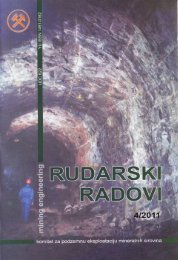Institut za rudarstvo i metalurgiju Bor
Institut za rudarstvo i metalurgiju Bor
Institut za rudarstvo i metalurgiju Bor
Create successful ePaper yourself
Turn your PDF publications into a flip-book with our unique Google optimized e-Paper software.
Table 2. Degrees of metal leaching with<br />
water from concentrate after<br />
sulphati<strong>za</strong>tion<br />
Element Leaching degree, %<br />
Cu 96.7<br />
Fe 98.3<br />
Ag 0.2<br />
In the first phase of leaching, the zinc,<br />
copper and iron are removed from concentrate.<br />
The second phase is presented by the<br />
cyanide leaching for the aim of silver<br />
transfer into solution.<br />
Cyanide Leaching of Silver<br />
Laboratory investigations for cyanide<br />
leaching experiments on samples were<br />
carried out on the sulphati<strong>za</strong>tion process<br />
products after the recovery of copper, zinc<br />
and iron.<br />
Leaching parameters are:<br />
• Temperature: 25 o C<br />
• S:L ratio: 1:2<br />
• NaCN concentration: 0.15%<br />
• Stiring rate: 800 min -1<br />
• Oxidant: oxygen<br />
• Leaching time: 8 h<br />
• NaOH concentration: 0.03%<br />
• pH: 10 - 11<br />
The result of cyanide leaching test, obtained<br />
after 8 h of leaching, was 71.8 % Ag.<br />
Silver Leaching with Thiourea Directly<br />
from Concentrate<br />
The test of untreated concentrate leaching<br />
was carried out with thiourea as the reagent.<br />
The main advantage of this reagent is<br />
that it eliminates the pre-treatment concentrate<br />
processes of roasting and leaching. The<br />
economic effect is also achieved since leaching<br />
is the process with small power consumption<br />
(at temperature of 40 o C).<br />
A sample of 100 g of sulphide concentrate<br />
was treated with thioruea solution and<br />
addition of oxidizer at temperature of<br />
40 o C. The results are shown in Table 3.<br />
Table 3. Metals leaching degree<br />
Element Leaching degree, %<br />
Ag 47.40<br />
Zn 2.76<br />
Fe 14.01<br />
Pb 0.008<br />
Cu 1.16<br />
This preliminary test has shown that<br />
the silver leaching from untreated concentrate<br />
is possible. The following investigation<br />
will be aimed to the defining of optimal<br />
technological leaching parameters.<br />
CONCLUSION<br />
Based on the obtained experimental results<br />
of investigation the silver leaching<br />
from sulphide concentrate from the<br />
»Rudnik« mine, it could be concluded the<br />
following:<br />
1. Low temperature sulphati<strong>za</strong>tion of<br />
concentrate leads to the destruction<br />
of present metal sulphides<br />
2. Leaching degree of non-ferrous metals<br />
(copper, iron and zinc) over 95 %<br />
was obtained by leaching of<br />
sulphati<strong>za</strong>tion products with water<br />
3. Silver leaching degree of 71.8 % was<br />
obtained by cyanide leaching of<br />
silver in the presence of oxidant<br />
4. Silver leaching degree of 47.4 % was<br />
obtained by direct leaching of silver<br />
with thiourea from concentrate.<br />
Acknowledgements<br />
The authors are grateful to the Ministry<br />
of Science and Technological Development<br />
for financial support (Project TR :<br />
19002)<br />
No 1,2010. 87<br />
MINING ENGINEERING



